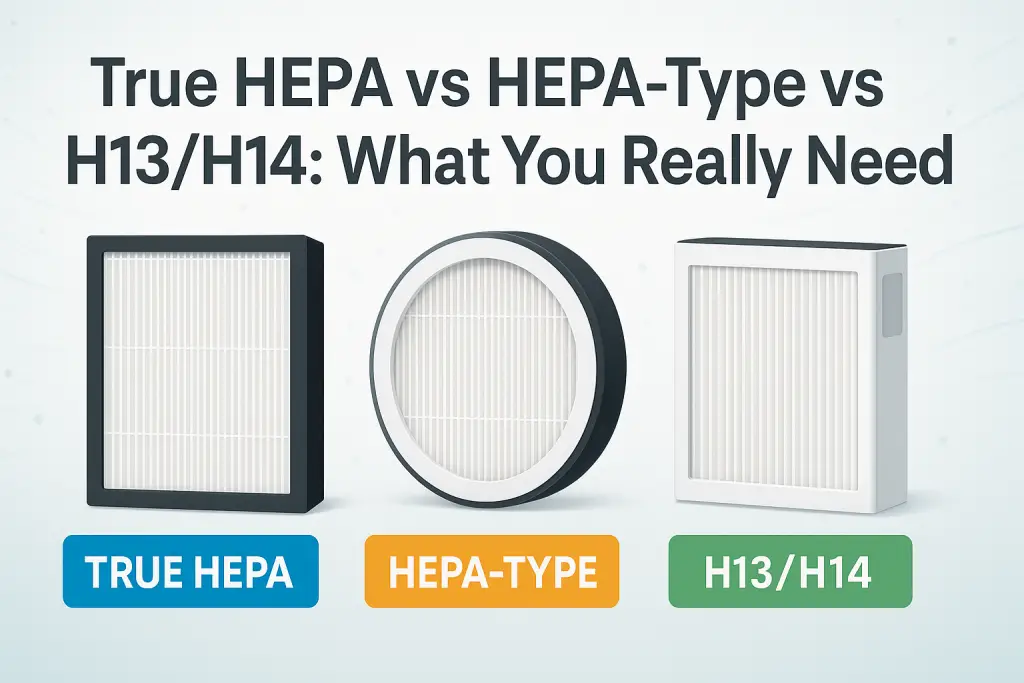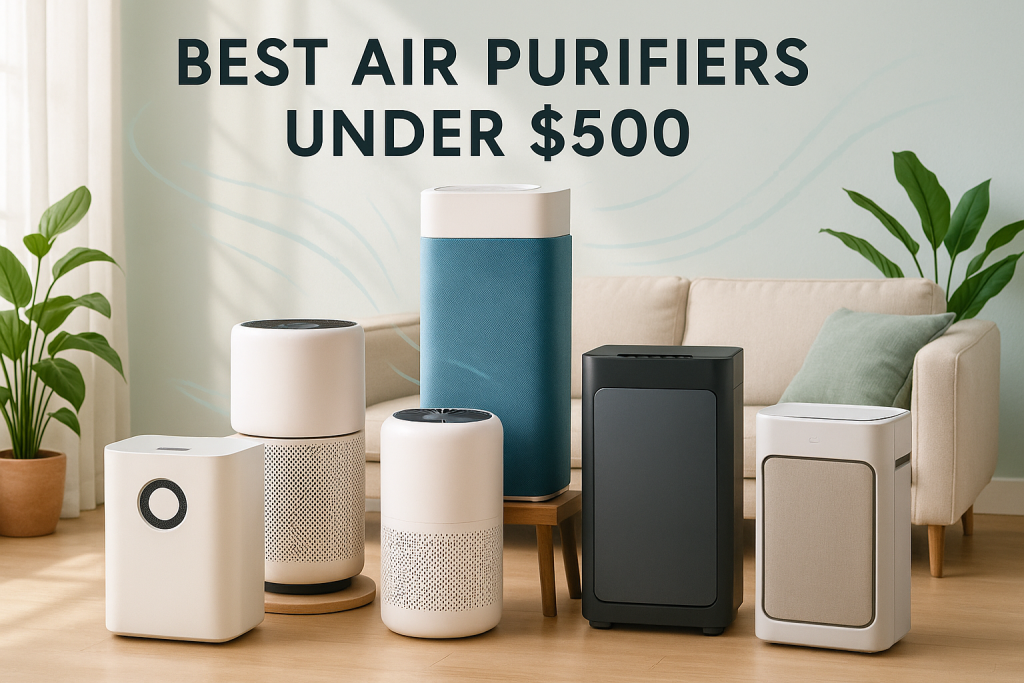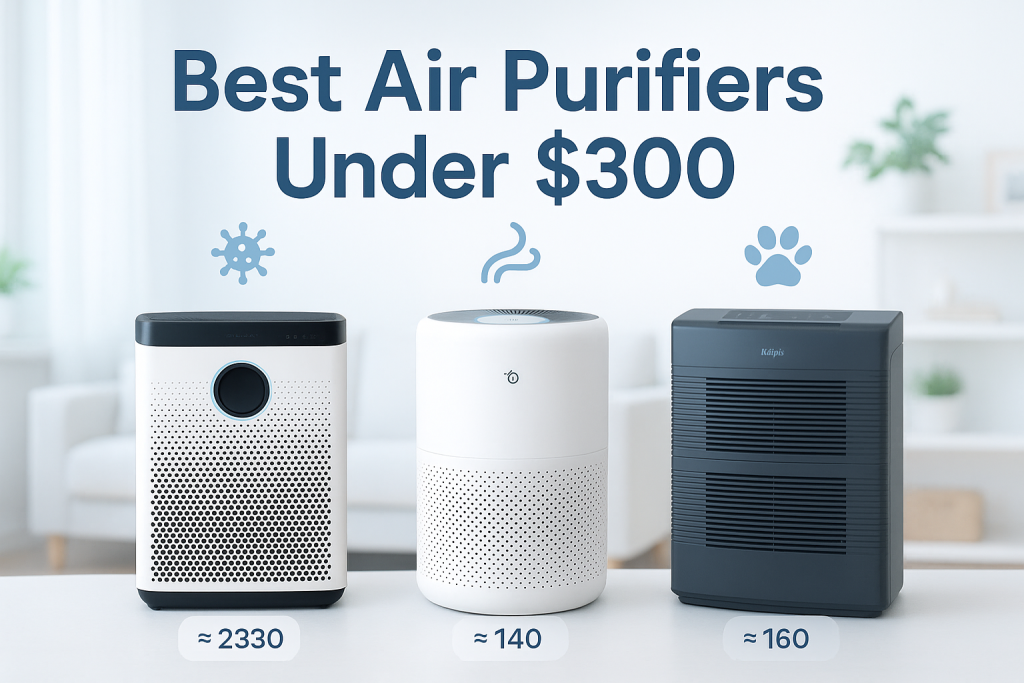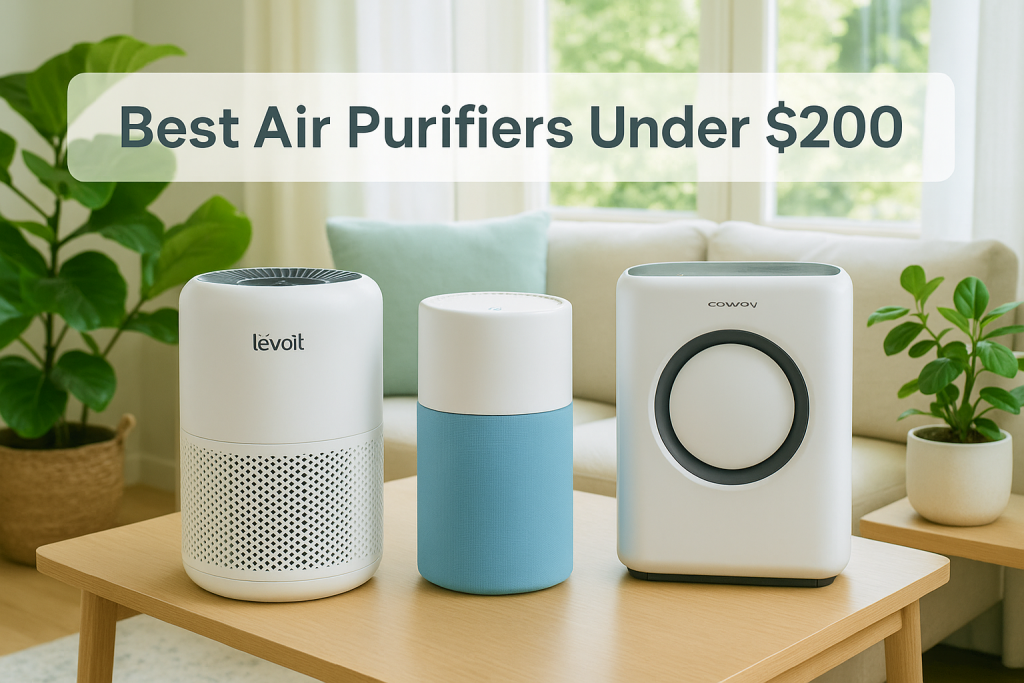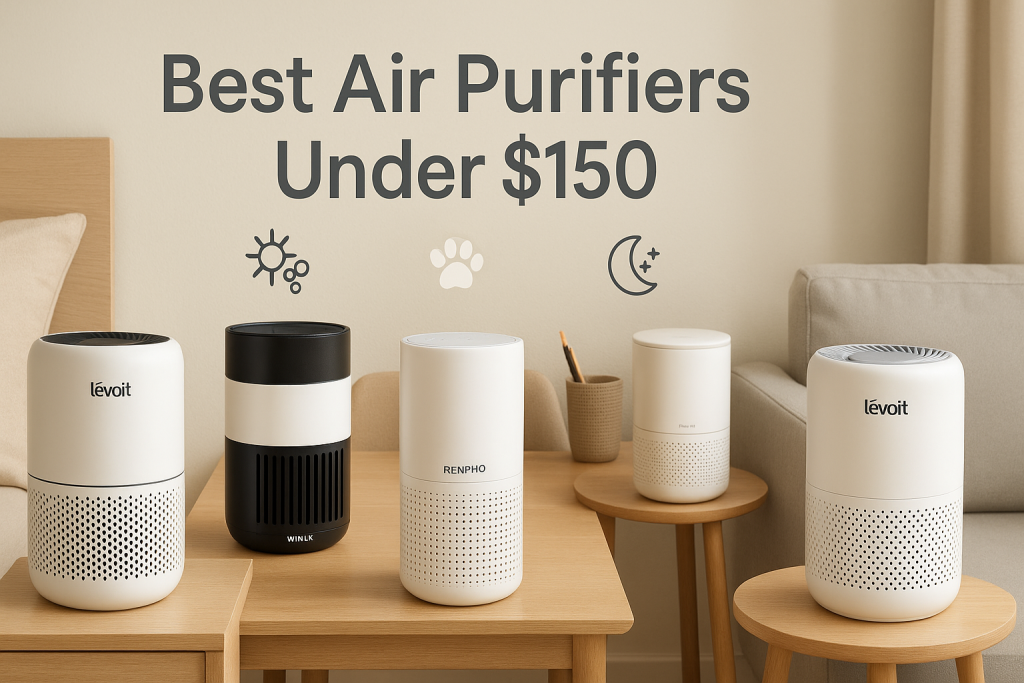Understanding HEPA filtration can be confusing with all the different classifications and marketing terms. True HEPA, HEPA-type, and H13/H14 filters represent different filtration standards with varying capabilities. This guide clarifies these differences and helps you determine which filter type you actually need based on your specific situation, health concerns, and budget.
Understanding HEPA Filter Classifications and Standards
HEPA (High Efficiency Particulate Air) filters are classified according to specific efficiency standards, but these standards vary globally and cause significant confusion. Different regions use different classification systems, making it challenging to compare products.
The main filter types include:
- True HEPA: Captures at least 99.97% of particles at 0.3 microns (US Department of Energy standard)
- HEPA-type: Captures between 85-95% of particles at 0.3 microns (no official certification)
- H13 HEPA: Captures 99.95% of particles at 0.3 microns (European EN 1822 standard)
- H14 HEPA: Captures 99.995% of particles at 0.3 microns (European EN 1822 standard)
These percentages might seem similar, but the difference between capturing 95% versus 99.97% of particles means that a True HEPA filter is about 166 times more effective than a basic HEPA-type filter. This efficiency gap becomes crucial when dealing with harmful particles.
| Photo | Popular Air Purifiers | Price |
|---|---|---|

|
Air Purifiers for Home Large Room up to 1500ft², Tailulu H13 True HEPA Air Purifier for Pets Dust Odor Smoke, Air Purifier for Bedroom with 15dB Quiet Sleep Mode for Bedroom Office Living Room | Check Price On Amazon |
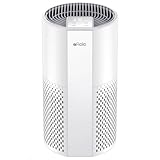
|
Afloia Air Purifier for Home, 4-in-1 Washable Filter for Allergies, Covers Up to 1076 ft², Quiet Operation, Auto Shut-Off & Night Light, Removes Pet Dander, Pollen, Dust, Mold, and Smoke, White,Pluto | Check Price On Amazon |

|
Nuwave OxyPure ZERO Air Purifier with Washable and Reusable Bio Guard Tech Air Filter, Large Room Up to 2002 Ft², Air Quality Monitor, 0.1 Microns, 100% Capture Irritants like Smoke, Dust, Pollen | Check Price On Amazon |

|
Air Purifiers for Home Large Room Up to 1,996 Ft², EOEBOT Air Purifier for Home Pets with Washable Filter, Quiet Sleep Mode, Air Quality Monitor, Air Purifier for Bedroom, Pet Hair, Dust, Smoke, White | Check Price On Amazon |

|
Afloia 2 IN 1 Air Purifier with Humidifier Combo, 3-Stage Filters for Home Allergies Pets Hair Smoker Odors, Evaporative Humidifier, Auto Shut Off, Quiet Air Cleaner with Seven Color Light,White | Check Price On Amazon |
What Makes a Filter “True HEPA”?
A True HEPA filter must meet the strict standard set by the US Department of Energy: capturing at least 99.97% of particles at 0.3 microns in size. This specific particle size (0.3 microns) is known as the Most Penetrating Particle Size (MPPS) – particles this size are the most difficult to capture.
True HEPA filters have distinct physical characteristics:
- Dense, fibrous material typically made from fiberglass
- Numerous deep pleats to increase surface area
- Sealed frame to prevent air bypass
- Certification testing under controlled conditions
These filters are commonly used in medical facilities, laboratories, and high-quality air purifiers. The real-world differences between True HEPA and HEPA-type filters become apparent when dealing with fine particles that impact respiratory health.
HEPA-Type Filters: Lower Standards and Limitations
HEPA-type filters (sometimes labeled as ‘99% HEPA’ or ‘HEPA-like’) fall short of True HEPA certification, typically capturing between 85-95% of particles at 0.3 microns. Manufacturers use creative marketing terms like “HEPA-style,” “HEPA-grade,” or “99% HEPA” to imply performance similar to True HEPA without meeting the actual standards.
These filters differ from True HEPA in several ways:
- Less dense filter media with fewer fibers
- Fewer pleats, reducing overall surface area
- Often thinner material that allows more particles to pass through
- Usually 20-50% cheaper than True HEPA filters
While HEPA-type filters can capture larger particles like dust and some pollen, they struggle with smaller allergens, bacteria, and fine particles that trigger respiratory issues.
H13 and H14 Filters: The European High-Performance Standards
H13 and H14 represent the highest grades of HEPA filtration under the European EN 1822 standard, offering even greater efficiency than standard True HEPA filters. These classifications are part of a comprehensive system that categorizes filters from E10 to H14, with higher numbers indicating better performance.
Key specifications include:
- H13 HEPA: 99.95% efficiency at 0.3 microns (more stringent than US True HEPA)
- H14 HEPA: 99.995% efficiency at 0.3 microns (10x more efficient than US True HEPA)
These high-performance filters are particularly valuable in cleanrooms, medical facilities, and pharmaceutical manufacturing. For residential use, H13 filters are becoming more common in premium air purifiers, especially those designed for people with severe allergies or respiratory conditions.
The Science Behind HEPA Filtration: How They Work
HEPA filters capture particles through multiple mechanisms, not just by acting as a simple sieve – understanding these processes helps explain the performance differences between filter grades. The filtration process is more complex than many realize.
The four primary capture mechanisms include:
- Interception: Particles follow airflow but stick to fibers when they come in contact
- Impaction: Larger particles with more momentum hit and stick to fibers directly
- Diffusion: Tiny particles move erratically (Brownian motion) and eventually contact fibers
- Electrostatic attraction: Some particles are naturally attracted to filter fibers
The Most Penetrating Particle Size (MPPS) of 0.3 microns represents the size where these mechanisms are least effective. Particles larger or smaller than this size are actually captured more efficiently, which is why HEPA testing focuses on this challenging particle size.
Filter Construction Differences: What Sets Each Type Apart
The physical construction of each filter type reveals why performance varies so dramatically between HEPA-type, True HEPA, and H13/H14 filters. These differences directly impact their ability to capture particles.
| Feature | HEPA-type | True HEPA | H13/H14 |
|---|---|---|---|
| Fiber density | Lower | High | Very high |
| Pleating | Minimal (20-40) | Extensive (50-70) | Maximum (70-100+) |
| Frame sealing | Often unsealed | Sealed | Thoroughly sealed |
| Material thickness | Thinner | Standard | Thicker |
Higher-grade filters use more sophisticated manufacturing processes, including hot-melt separators, deeper pleating techniques, and advanced fiber arrangements. These construction differences create more opportunities for particles to be captured as air flows through the filter.
Performance Comparison: What Each Filter Type Actually Captures
The practical filtration differences between HEPA-type, True HEPA, and H13/H14 filters are best understood by examining what specific contaminants each can effectively capture. While specifications provide theoretical performance, real-world effectiveness varies based on conditions and contaminants.
| Contaminant | Size (microns) | HEPA-type | True HEPA | H13/H14 |
|---|---|---|---|---|
| Dust | 2.5-10 | 85-90% | 99.97%+ | 99.99%+ |
| Pollen | 10-100 | 90%+ | 99.99%+ | 99.999%+ |
| Pet dander | 2.5-10 | 80-90% | 99.97%+ | 99.99%+ |
| Mold spores | 3-40 | 75-85% | 99.97%+ | 99.99%+ |
| Bacteria | 0.3-10 | 60-80% | 99.97%+ | 99.995%+ |
| Viruses | 0.01-0.3 | 30-70% | 95-99.97% | 99-99.999% |
Laboratory testing often shows better performance than real-world use due to factors like airflow rate, filter loading, humidity, and temperature. The difference between MERV ratings and HEPA standards further complicates comparing filtration systems.
Allergens, Viruses, and Bacteria: Filtration Effectiveness
For those concerned about specific health threats, understanding exactly what each filter type can capture is crucial for making the right selection. Different contaminants require different levels of filtration.
Key contaminants and their capture requirements:
- Dust mite allergens (10-40 microns): Even HEPA-type filters capture most, but proteins attached to smaller particles may require True HEPA
- Pet allergens (5-10 microns, but can attach to particles as small as 0.1 microns): True HEPA recommended for pet allergy sufferers
- Pollen (10-100 microns): Most filters capture the intact grains, but fragments can be smaller
- Bacteria (0.3-10 microns): True HEPA or better needed for reliable capture
- Viruses (0.01-0.3 microns): H13/H14 provides the most reliable capture due to virus size often being smaller than the MPPS
According to studies published in the Journal of Aerosol Science, True HEPA filters capture over 99.9% of influenza viruses when attached to larger particles, while HEPA-type filters capture only 60-80% under the same conditions.
Smoke, VOCs, and Ultra-fine Particles: Where HEPA Filters Fall Short
While HEPA filters excel at capturing particulates, all HEPA classifications have inherent limitations when it comes to certain contaminants. Understanding these limitations is essential to creating a complete air purification strategy.
HEPA filters cannot effectively remove VOCs or gaseous pollutants because these molecules are much smaller than the particles HEPA filters are designed to trap. These limitations include:
- Wildfire smoke: Contains both particles (which HEPA can capture) and gases (which it cannot)
- Cooking fumes: Similar to smoke, includes particles and gases
- VOCs (Volatile Organic Compounds): These gaseous pollutants pass through all HEPA filters
- Ultra-fine particles (below 0.1 microns): Captured with varying effectiveness depending on filter grade
To address these limitations, combining HEPA with activated carbon filtration provides more comprehensive air cleaning. Activated carbon adsorbs gases and odors that HEPA filters miss.
What You Actually Need: Matching Filter Type to Your Situation
The right HEPA filter for your needs depends on specific health concerns, environmental factors, and budget considerations – not everyone needs the highest filtration level. Making the right choice can save money while still addressing your specific air quality concerns.
Here’s a decision framework for different scenarios:
For General Household Use (Mild to Moderate Allergies)
- Recommended: True HEPA
- Why: Captures 99.97% of common allergens and provides reliable air cleaning for most households
- Cost consideration: Moderately priced with reasonable replacement filter costs
For Severe Allergy or Asthma Sufferers
- Recommended: H13 HEPA
- Why: Higher capture rate provides additional protection for sensitive individuals
- Cost consideration: Higher initial and replacement costs justified by health benefits
For Homes with Pets
- Recommended: True HEPA with pre-filter
- Why: Captures pet dander while pre-filter handles fur and larger particles
- Cost consideration: Replaceable pre-filter extends main filter life, reducing long-term costs
For Homes in Areas with Wildfire Risk
- Recommended: True HEPA or H13 with substantial activated carbon
- Why: Handles smoke particles while carbon addresses gaseous components
- Cost consideration: Higher cost justified during fire seasons or in high-risk areas
For Immunocompromised Individuals
- Recommended: H13 or H14 HEPA
- Why: Provides maximum protection against airborne pathogens
- Cost consideration: Higher cost justified by medical necessity
When H13 or H14 Filters Are Worth the Investment
H13 and H14 filters represent the highest level of HEPA filtration available, but their additional cost and energy requirements aren’t necessary for everyone. These premium filters typically cost 30-50% more than standard True HEPA filters and may increase energy consumption by 10-20% due to greater air resistance.
H13/H14 filters provide meaningful benefits in these situations:
- Medical conditions requiring maximum air purification (severe asthma, COPD, immunocompromised status)
- Homes in areas with extremely poor outdoor air quality
- Professional settings like dental offices, medical clinics, and laboratories
- Households with multiple allergy or asthma sufferers
For most healthy individuals with normal respiratory function, the difference between True HEPA and H13/H14 performance may not justify the additional cost. However, for those with serious health concerns, the extra protection can be valuable.
When HEPA-Type Filters Are Sufficient (And When They’re Not)
Despite their limitations, HEPA-type filters can be adequate for certain situations, particularly when budget constraints are a primary concern. These more affordable options typically cost 40-60% less than True HEPA filters.
HEPA-type filters may be sufficient for:
- Removing visible dust and larger allergens in homes without allergy sufferers
- Secondary rooms that don’t require maximum filtration
- Temporary or short-term use situations
- Supplemental filtration alongside a main True HEPA system
However, HEPA-type filters are inadequate for:
- Anyone with respiratory conditions, allergies, or asthma
- Homes with pets, smokers, or cooking fumes
- Areas with poor outdoor air quality
- Capturing bacteria, viruses, or fine particulate matter
Warning signs that your current HEPA-type filtration is insufficient include persistent allergy symptoms, visible dust accumulation shortly after cleaning, and lingering odors.
Beyond Filter Class: Other Crucial Air Purifier Considerations
While filter classification is important, several other factors significantly impact real-world air purification performance and should influence your purchasing decision. The most efficient filter is only effective when part of a well-designed system.
Key considerations include:
- CADR (Clean Air Delivery Rate): Measures how quickly the unit can clean air; higher numbers mean faster purification
- Room size rating: Make sure the purifier is rated for your space (larger than your room is better)
- Air changes per hour: 4-5 air changes hourly is ideal for most homes
- Filter lifespan: Longer-lasting filters reduce maintenance and replacement costs
- Noise levels: Especially important in bedrooms and living spaces
- Energy consumption: Higher-grade filters may require more powerful fans, increasing electricity usage
For proper air purification, match your purifier to your room size and run it consistently rather than intermittently. A perfectly-sized True HEPA purifier running continuously will outperform an oversized unit that’s rarely used.
The Importance of Pre-Filters and Multi-Stage Filtration
A high-quality pre-filter can dramatically extend the life of your main HEPA filter while improving overall system performance. Multi-stage filtration addresses different types of pollutants that no single filter can handle alone.
An effective multi-stage system typically includes:
- Washable pre-filter: Captures hair, large dust, and visible particles
- Medium-filter: Traps smaller dust and allergens before they reach the HEPA
- HEPA filter: Removes fine particles and allergens
- Activated carbon: Adsorbs gases, VOCs, and odors
- Optional technologies: UV light, ionization (though effectiveness varies)
A good pre-filter can extend your main HEPA filter’s life by 3-6 months, significantly reducing long-term costs. For homes with pets, a robust pre-filter is especially important as pet hair can quickly clog more expensive HEPA filters.
When choosing between HEPA vacuums and regular models, similar principles apply – the filtration system matters for maintaining indoor air quality.
Verifying Manufacturer Claims: How to Avoid Marketing Hype
The air purifier market is filled with misleading terminology and exaggerated claims – here’s how to verify what you’re really getting. Many manufacturers use creative wording to imply their products meet standards they don’t actually achieve.
Common misleading terms include:
- “HEPA-type”: Not True HEPA certified
- “99% HEPA”: Sounds impressive but falls short of the 99.97% True HEPA standard
- “HEPA-like”: Has no standard definition or certification
- “Captures particles as small as 0.3 microns”: Doesn’t specify what percentage is captured
To verify claims, look for:
- Specific efficiency percentages (99.97% for True HEPA, 99.95% for H13, etc.)
- Certification from recognized testing organizations
- Detailed specification sheets with test results
- References to specific standards (DOE, EN 1822)
Be wary of manufacturers who won’t provide specific test results or who use vague terminology in their marketing materials.
Third-Party Testing and Certification: What to Look For
Legitimate third-party certifications provide the most reliable verification of filter performance claims. These independent assessments ensure that manufacturers meet the standards they claim.
Reputable testing organizations include:
- AHAM (Association of Home Appliance Manufacturers): Verifies CADR ratings
- CARB (California Air Resources Board): Certifies air cleaners for ozone emissions
- Energy Star: Certifies energy efficiency
- TÜV, SGS, and Intertek: Provide independent verification of filtration claims
Look for certification logos on packaging and product descriptions. Legitimate certifications will include specific test numbers and results that you can verify on the certification organization’s website.
When in doubt, contact the manufacturer directly and ask for specific test results and certification information. Reputable companies will readily provide this documentation.
Conclusion: Making Your Final Filter Decision
Choosing between HEPA-type, True HEPA, and H13/H14 filters ultimately comes down to balancing your specific air quality needs with practical considerations. There’s no one-size-fits-all solution, but understanding the real differences helps you make an informed choice.
Key takeaways:
- True HEPA (99.97% efficiency) is sufficient for most households and provides excellent protection against common allergens and particles
- H13/H14 filters offer enhanced protection that benefits those with severe allergies, respiratory conditions, or compromised immune systems
- HEPA-type filters have significant limitations but may be adequate for homes without specific health concerns
- Consider the complete filtration system, not just the HEPA component
- Verify manufacturer claims through third-party certifications
Remember that consistent use of a properly sized True HEPA air purifier will provide better results than an occasionally used premium model. Your air quality needs may also change seasonally or as your health situation evolves, so be prepared to adjust your filtration strategy accordingly.
When health concerns are significant, investing in higher-grade filtration is worthwhile. For most households, True HEPA provides the optimal balance of performance and value.
| Photo | Air Purifier Model | Best for | Price |
|---|---|---|---|

|
LEVOIT Air Purifier | Best Overall | Check Price On Amazon |

|
WINIX A231 Air Purifier | Asthma & Indoor Pollution | Check Price On Amazon |

|
Rabbit Air, A3 SPA-1000N Air Purifier | Pet Dander & Odors | Check Price On Amazon |

|
GermGuardian Air Purifier | Cigarette & Cooking Smoke | Check Price On Amazon |

|
Coway Airmega Air Purifier | New-borns | Check Price On Amazon |

|
BLUEAIR Air Purifier | Germ & Virus Control | Check Price On Amazon |
